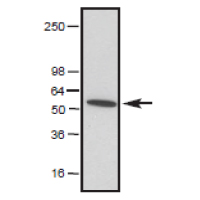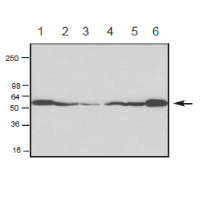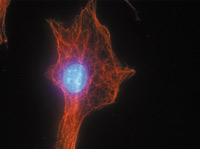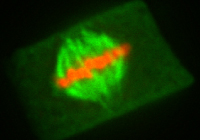| Author | Title | Journal | Year | Article Link |
|---|
| Cree, Tabitha et al. | FKBP25 regulates myoblast viability and migration and is differentially expressed in in vivo models of muscle adaptation | The FEBS Journal | 2023 | ISSN 1742--4658 |
| Pust, Sascha et al. | Vesicle-mediated transport of ALIX and ESCRT-III to the intercellular bridge during cytokinesis | Cellular and Molecular Life Sciences 2023 80:8 | 2023 | ISSN 1420--9071 |
| Turner, Katerina A. et al. | CP110 and CEP135 localize near the proximal and distal centrioles of cattle and human spermatozoa | microPublication Biology | 2023 | ISSN 2578--9430 |
| Turner, Katerina A. et al. | Tubulin posttranslational modifications modify the atypical spermatozoon centriole | microPublication Biology | 2022 | ISSN 2578--9430 |
| Alata, Milvia et al. | H-ABC tubulinopathy revealed by label-free second harmonic generation microscopy | Scientific Reports 2022 12:1 | 2022 | ISSN 2045--2322 |
| Guerra San Juan, Irune et al. | Loss of mouse Stmn2 function causes motor neuropathy | Neuron | 2022 | ISSN 0896-6273 |
| Kriek, Neline et al. | Cucurbitacins elicit anti-platelet activity via perturbation of the actin cytoskeleton and integrin function. | Thrombosis and Haemostasis | 2022 | ISSN 0340--6245 |
| Ibarrola-Vannucci, Ana K. et al. | Characterization and functional analysis of the proteins Prohibitin 1 and 2 in Trypanosoma cruzi | PLOS Neglected Tropical Diseases | 2021 | ISSN 1935--2735 |
| Dixon, Charles R. et al. | STING nuclear partners contribute to innate immune signaling responses | iScience | 2021 | ISSN 2589-0042 |
| Creighton, Blake A. et al. | Giant ankyrin-B mediates transduction of axon guidance and collateral branch pruning factor sema 3A | eLife | 2021 | ISSN 2050-084X |
| Xie, Xuan et al. | α-TubK40me3 is required for neuronal polarization and migration by promoting microtubule formation | Nature Communications | 2021 | ISSN 2041-1723 |
| Kumar Gaire, Sunil et al. | Accelerating multicolor spectroscopic single-molecule localization microscopy using deep learning | Biomedical Optics Express | 2020 | ISSN 2156--7085 |
| Batlle, Cristina et al. | hnRNPDL Phase Separation Is Regulated by Alternative Splicing and Disease-Causing Mutations Accelerate Its Aggregation | Cell Reports | 2020 | ISSN 2211-1247 |
| Samson, Andre L. et al. | MLKL trafficking and accumulation at the plasma membrane control the kinetics and threshold for necroptosis | Nature Communications | 2020 | ISSN 2041-1723 |
| Song, Ki Hee et al. | Symmetrically dispersed spectroscopic single-molecule localization microscopy | Light: Science and Applications | 2020 | ISSN 2047-7538 |
| Lemjabbar-Alaoui, Hassan et al. | AMXI-5001, a novel dual parp1/2 and microtubule polymerization inhibitor for the treatment of human cancers. | American journal of cancer research | 2020 | ISSN 2156--6976 |
| Yang, Yu et al. | Identification of the repressive domain of the negative circadian clock component CHRONO | International Journal of Molecular Sciences | 2020 | ISSN 1422-0067 |
| Hirst, William G. et al. | Differences in Intrinsic Tubulin Dynamic Properties Contribute to Spindle Length Control in Xenopus Species | Current Biology | 2020 | ISSN 1879-0445 |
| Roldán, Adrian Saul Jimenez et al. | 3,3′-Thiodipropanol As a Versatile Refractive Index-Matching Mounting Medium for Fluorescence Microscopy | Biomedical Optics Express | 2019 | ISSN 2156--7085 |
| Fu, Meng meng et al. | The Golgi Outpost Protein TPPP Nucleates Microtubules and Is Critical for Myelination | Cell | 2019 | ISSN 1097-4172 |
| Sasaki, Takema et al. | A Novel Katanin-Tethering Machinery Accelerates Cytokinesis | Current Biology | 2019 | ISSN 0960-9822 |
| Song, Ki-Hee et al. | Three-dimensional biplane spectroscopic single-molecule localization microscopy: erratum | Optica | 2019 | Article Link |
| Even, Aviel et al. | ATAT1-enriched vesicles promote microtubule acetylation via axonal transport | Science Advances | 2019 | ISSN 2375-2548 |
| Lie-Jensen, Anette et al. | Centralspindlin Recruits ALIX to the Midbody during Cytokinetic Abscission in Drosophila via a Mechanism Analogous to Virus Budding | Current Biology | 2019 | ISSN 0960-9822 |
| Schopfer, Lawrence M. et al. | Chlorpyrifos oxon promotes tubulin aggregation via isopeptide cross-linking between diethoxyphospho-Lys and Glu or ASP: Implications for neurotoxicity | Journal of Biological Chemistry | 2018 | ISSN 1083-351X |
| Morelli, Giovanni et al. | p27Kip1 Modulates Axonal Transport by Regulating α-Tubulin Acetyltransferase 1 Stability | Cell Reports | 2018 | ISSN 2211-1247 |
| Xu, Xiaoxue et al. | Probenecid disrupts a novel pannexin 1-collapsin response mediator protein 2 interaction and increases microtubule stability | Frontiers in Cellular Neuroscience | 2018 | ISSN 1662-5102 |
| Stojkov, Darko et al. | ROS and glutathionylation balance cytoskeletal dynamics in neutrophil extracellular trap formation | Journal of Cell Biology | 2017 | ISSN 1540-8140 |
| Winfree, Lilly M. et al. | Protein phosphatase 4 coordinates glial membrane recruitment and phagocytic clearance of degenerating axons in Drosophila | Cell Death and Disease | 2017 | ISSN 2041-4889 |
| Lee, Yuh Ru Julie et al. | The Mitotic Function of Augmin Is Dependent on Its Microtubule-Associated Protein Subunit EDE1 in Arabidopsis thaliana | Current Biology | 2017 | ISSN 0960-9822 |
| Horita, Henrick et al. | Identifying Regulatory Posttranslational Modifications of PD-L1: A Focus on Monoubiquitinaton | Neoplasia (United States) | 2017 | ISSN 1476-5586 |
| Zhang, Yu Shrike et al. | Hybrid Microscopy: Enabling Inexpensive High-Performance Imaging through Combined Physical and Optical Magnifications | Scientific Reports | 2016 | ISSN 2045-2322 |
| Westmoreland, D. et al. | Super-resolution microscopy as a potential approach to diagnosis of platelet granule disorders | Journal of Thrombosis and Haemostasis | 2016 | ISSN 1538-7836 |
| Zimmermann, Maike et al. | Cyclin G2 promotes cell cycle arrest in breast cancer cells responding to fulvestrant and metformin and correlates with patient survival | Cell Cycle | 2016 | ISSN 1551-4005 |
| Bouge, Anne Laure et al. | Tau excess impairs mitosis and kinesin-5 function, leading to aneuploidy and cell death | DMM Disease Models and Mechanisms | 2016 | ISSN 1754-8411 |
| Ferraro, Francesco et al. | Weibel-Palade body size modulates the adhesive activity of its von Willebrand Factor cargo in cultured endothelial cells | Scientific Reports | 2016 | ISSN 2045-2322 |
| Tillberg, Paul W. et al. | Protein-retention expansion microscopy of cells and tissues labeled using standard fluorescent proteins and antibodies | Nature Biotechnology | 2016 | ISSN 1546-1696 |
| Berruti, Giovanna et al. | USP8/UBPy-regulated sorting and the development of sperm acrosome: The recruitment of MET | Reproduction | 2015 | ISSN 1741-7899 |
| Petrini, Stefania et al. | Intracellular distribution of glutathionylated proteins in cultured dermal fibroblasts by immunofluorescence | Methods in Molecular Biology | 2015 | ISSN 1064-3745 |
| Valenzuela-Iglesias, A. et al. | Profilin1 regulates invadopodium maturation in human breast cancer cells | European Journal of Cell Biology | 2015 | ISSN 1618-1298 |
| McLane, Joshua S. et al. | Palladin Mediates Stiffness-Induced Fibroblast Activation in the Tumor Microenvironment | Biophysical Journal | 2015 | ISSN 1542-0086 |
| Piroli, Gerardo G. et al. | Identification of protein succination as a novel modification of tubulin | Biochemical Journal | 2014 | ISSN 1470-8728 |
| Lepicard, Simon et al. | A presynaptic role of microtubule-associated protein 1/Futsch in Drosophila: Regulation of active zone number and neurotransmitter release | Journal of Neuroscience | 2014 | ISSN 1529-2401 |
| Zimmermann, Maike et al. | Elevated cyclin G2 expression intersects with DNA damage checkpoint signaling and is required for a potent G2/M checkpoint arrest response to doxorubicin | Journal of Biological Chemistry | 2012 | ISSN 0021-9258 |
| Racedo, S. E. et al. | Dynamic changes of the Golgi apparatus during bovine in vitro oocyte maturation | Reproduction | 2012 | ISSN 1470-1626 |
| Ho, Chin Min Kimmy et al. | Augmin plays a critical role in organizing the spindle and phragmoplast microtubule arrays in Arabidopsis | The Plant cell | 2011 | ISSN 1532--298X |
| Davis, Ashley et al. | A tubulin polymerization microassay used to compare ligand efficacy | Methods in Cell Biology | 2010 | ISSN 0091-679X |
| Parrotta, Luigi et al. | Changes in the accumulation of α- and β-tubulin during bud development in Vitis vinifera L. | Planta | 2010 | ISSN 0032-0935 |
| Del Duca, Stefano et al. | Effects of post-translational modifications catalysed by pollen transglutaminase on the functional properties of microtubulesand actin filaments | Biochemical Journal | 2009 | ISSN 1470-8728 |
| Jin, Li Qing et al. | Axon regeneration in the absence of growth cones: Acceleration by cyclic AMP | Journal of Comparative Neurology | 2009 | ISSN 0021-9967 |
| Fujikake, Nobuhiro et al. | Heat shock transcription factor 1-activating compounds suppress polyglutamine-induced neurodegeneration through induction of multiple molecular chaperones | The Journal of biological chemistry | 2008 | ISSN 0021--9258 |
| Hanson, Susan M. et al. | Arrestin Mobilizes Signaling Proteins to the Cytoskeleton and Redirects their Activity | Journal of Molecular Biology | 2007 | ISSN 0022-2836 |
| Semenova, Irina et al. | Fluorescence microscopy of microtubules in cultured cells. | Methods in molecular medicine | 2007 | ISSN 1543-1894 |
| Van De Wetering, C. I. et al. | Erratum: Chromosomal instability and supernumerary centrosomes represent precursor defects in a mouse model of T-cell lymphoma (Cancer Research (2007) 67, (8081-8088)) | Cancer Research | 2007 | ISSN 0008-5472 |
| Ganot, Philippe et al. | Comparative organization of follicle, accessory cells and spawning anlagen in dynamic semelparous clutch manipulators, the urochordate Oikopleuridae | Biology of the Cell | 2006 | ISSN 0248-4900 |
| Morito, Yuki et al. | Dynamics of microtubules and positioning of female pronucleus during bovine parthenogenesis | Biology of Reproduction | 2005 | ISSN 0006-3363 |
| Sanbe, Atsushi et al. | Desmin-related cardiomyopathy in transgenic mice: A cardiac amyloidosis | Proceedings of the National Academy of Sciences of the United States of America | 2004 | ISSN 0027-8424 |
| Payne, Christopher et al. | Preferentially localized dynein and perinuclear dynactin associate with nuclear pore complex proteins to mediate genomic union during mammalian fertilization | Journal of Cell Science | 2003 | ISSN 0021-9533 |








